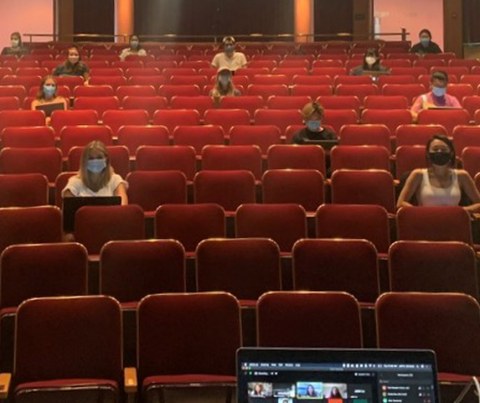Cornell non-academic units join the classrooms: a win-win story

Hands-on work is a great way to learn. So when students learning data analytics can practice their skills with data from a real business, it’s a win for the students. And when this data come from campus units, it can also be a win for these units in unexpected ways.
Each year, students enrolled in INFO 4555 (Business Intelligence Systems) learn data modelling and visualization techniques. They have the opportunity to analyze financial, performance, or resource utilization data from one or two units on campus who sponsor the class. Working on real data is beneficial to the students in several ways. Real data are imperfect and they are more difficult to work with than fabricated data, so it stretches students’ skills further. Also, students experience what real requirements from a real sponsor may look like. And when they present their end-of-semester project, students have a real story to tell. “This is a good resume builder,” says Jeff Christen, an instructor for the College of Computing and Information Science, who teaches INFO 4555.
The class gathers students from different colleges. In project teams, a student can be a business major, another one a history major, or a German major, says Christen. Because the data extraction, transformation, and analysis involves computer programming, the class can be challenging for students who come from these majors. But computer science majors do not always do the best. “Sometimes, you have these teams where students are all programming hotshots, and you really expect them to knock it out of the park. But it’s not the case,” says Christen. “The teams that do the best have a blend,” With real data, students look at a business process, which extends beyond a pure logic or programming problem. In the data analytics space, business acumen, presentation skills, and data visualization are also valuable. “We see really cool results by having this diversity,” says Christen. “There is not one major that is the perfect major for it.”
Really cool results translate into great presentations at the end of the semester. It is exciting when it comes together, says Christen, because sometimes at the last checkpoint they still have quite a bit of work to do. “I don’t have too much insight into what they have done in that final stretch. I’m nervous, usually,” says Christen. As a teacher, he hopes that everything will come together at the end, all the techniques students learned during classes, through the different assignments, and the work they did as a team. This year with COVID, teamwork was especially challenging. After Thanksgiving, teaching went fully remote. In some teams, student were as many as twelve time zones apart, says Christen. “It was a challenging semester, but students have done a wonderful job.”
Teams are partially graded on their creativity, which sometimes leads to fortuitous discoveries. Real data are often imperfect, and finding interesting anomalies in the data is what can set a team apart from another team working on the same project. This year, a team uncovered a small error in the sponsor’s database. “It was really a tiny detail but now, knowing this, I can remove this outlier and correct our data,” says James VanEe, associate director of the Biotechnology Resource Center (BRC). The Cornell Institute of Biotechnology’s BRC was this year’s sponsor. Both Christen and VanEe agree that finding mistakes in the data is not the point of the exercise. “Our goal is to give students real-life problems, we are not looking for free work,” says VanEe.
Even if students do not provide new insights into the business process, there are tangible benefits for the sponsors to watching the students present their findings. For one thing, students are not scared to try new things. “Some presentations are quite innovative and they changed the way I look at data. Students inspire me to visualize data in some new ways,” says VanEe.
But what is maybe the most important benefit is simply the connection with the students. When he is not teaching the class, Christen is full-time manager of the Data Warehousing and Integrations unit at Cornell Information Technologies (CIT). For CIT as for the BRC and other non-academic units on campus, teaching is not the primary mission. So most staff in these units do not have daily contact with students. “It’s so cool to be able to work with student and remember ‘Oh yeah, that’s what Cornell is all about!’,” says Christen. For participating businesses, this feeling is the same. “We are not an academic unit, so teaching is not our priority, but sharing the BRC data with the students is a way to contribute to the teaching mission of the university. I think it’s nice that we can do that,” says VanEe.
Over the last five years, other sponsors such as Cornell Dining, Campus-to-Campus Bus Service, Animal Health Diagnostic Center at the College of Veterinary Medicine, and Cornell University Library, have volunteered to share their data and participate in what Christen calls a win-win model. “There are so many very brilliant students on campus that are looking for experience. We can leverage our smart students and give them experience” says Christen. “Students win and campus wins through this synergy between the two.” Now that the semester is over, it’s time for Christen to find a new sponsor and re-create that synergy next fall.
